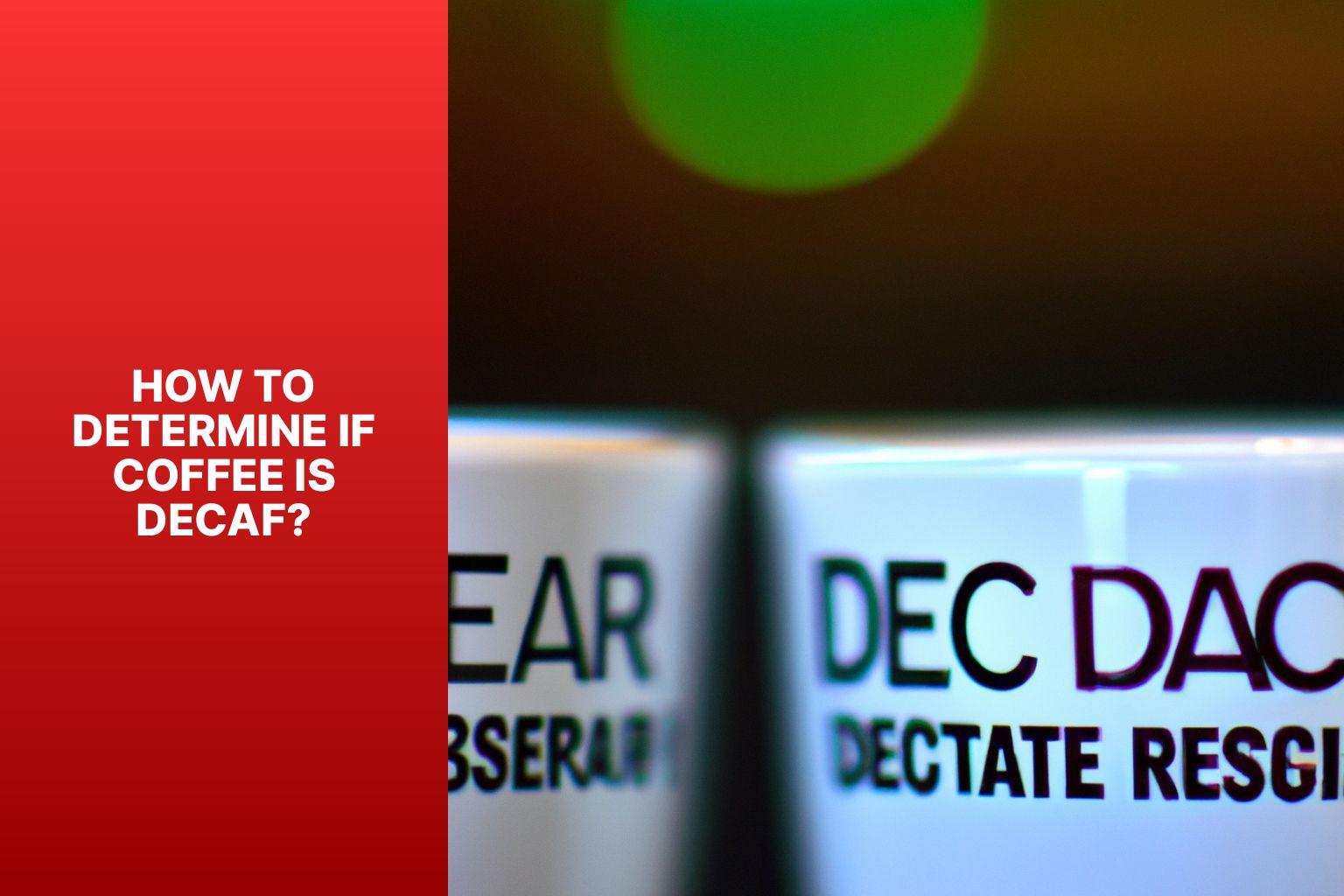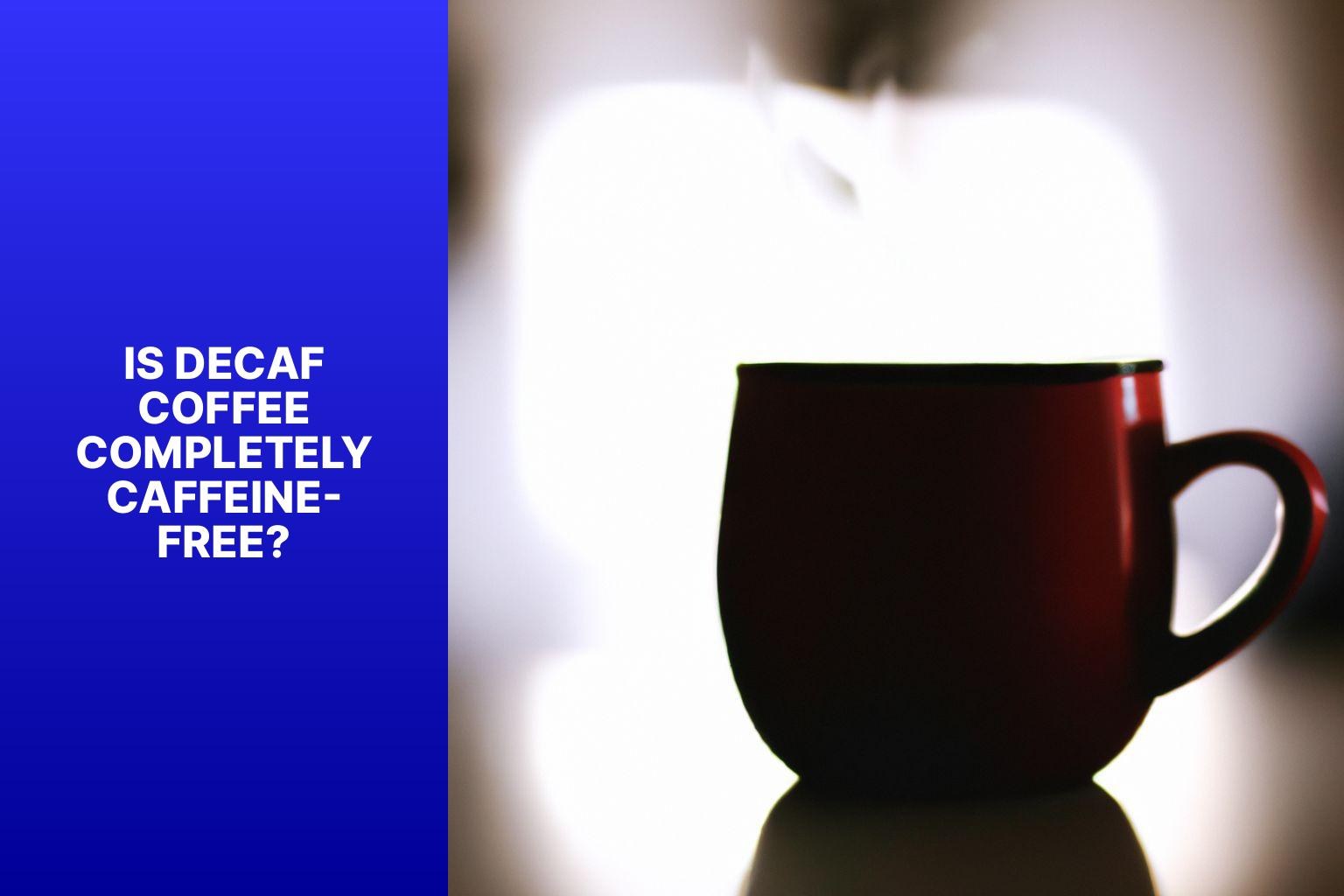Decaffeinated coffee, often referred to as decaf, is a popular option for those seeking to enjoy the taste and experience of coffee without the stimulating effects of caffeine. Whether you have a preference for decaf or want to double-check if the coffee you are consuming is truly caffeine-free, it’s essential to be able to spot the difference. Here are the key aspects to consider when determining if coffee is decaf.
Understanding the process of decaffeination is crucial. Decaf coffee is made by removing most of the caffeine from the coffee beans while preserving the flavor compounds. Various methods are employed to achieve this, such as the Swiss Water Process, carbon dioxide extraction, or chemical solvents like methyl chloride or ethyl acetate.
People choose decaf coffee for several reasons. Some may have sensitivity to caffeine, while others may want to avoid the stimulating effects that can disrupt sleep or cause increased heart rate. Decaf is also a suitable option for pregnant women or individuals with certain medical conditions that require reduced caffeine intake.
To determine if coffee is decaf, you can employ various methods. Reading the label is a straightforward approach, as coffee packaging usually indicates whether the product is decaffeinated. Look for terms like “decaf” or “caffeine-free.” specific certifications like the Swiss Water Decaf Process or USDA Organic can provide assurance of decaf status.
Flavor differences can also be indicative of decaf coffee. Decaffeination can alter the taste profile slightly, resulting in a milder or less bitter flavor compared to regular coffee. Pay attention to any differences in taste if you suspect the coffee might be decaf.
For a more definitive answer, home testing kits are available to check caffeine levels in coffee. These kits utilize chemical reactions to detect the presence of caffeine and can provide a quantitative measurement of the caffeine content.
In cases where the coffee is purchased from a café or coffee shop, don’t hesitate to ask the barista or seller directly. They can provide information on whether a particular brew is decaf or regular coffee.
While decaf coffee is generally considered safe for consumption, there may be some risks or side effects to consider. Certain individuals may still experience mild reactions to the remaining trace amounts of caffeine, including increased heart rate, insomnia, or gastrointestinal issues. It’s best to monitor your own tolerance and listen to your body’s response.
It’s important to note that decaf coffee is not completely caffeine-free. Despite the decaffeination process, there may still be minimal amounts of caffeine present in decaf coffee. The level is significantly lower compared to regular coffee, usually ranging from 2 to 7 milligrams per 8-ounce cup.
When it comes to taste, decaf coffee generally offers a similar flavor profile to regular coffee, albeit slightly milder. The process of decaffeination does alter some of the compounds in coffee beans, which can result in a smoother or less intense taste. With advancements in decaf processing methods, the difference in taste is becoming increasingly subtle.
By understanding the process of decaffeination and employing different methods to determine if coffee is decaf, you can confidently enjoy a cup of coffee that suits your preferences and requirements.
What is Decaffeinated Coffee?
Decaffeinated coffee is coffee that has had most of the caffeine removed. This is done before roasting the coffee beans. There are different methods used to decaffeinate coffee, including the Swiss Water Process, direct solvent method, and carbon dioxide method. These methods aim to remove around 97-99% of the caffeine from the coffee beans.
What is decaffeinated coffee? It is a good choice for people who want to enjoy the flavor and aroma of coffee without the effects of caffeine. It is popular for those who are sensitive to caffeine or want to limit their intake for different reasons.
When buying decaffeinated coffee, look for packaging that clearly indicates it is decaffeinated. This ensures you are getting the right product. Also consider the taste, as the decaffeination process can affect the flavor. Some decaffeinated coffees maintain the original taste, while others may have a slightly different flavor.
How is Decaf Coffee Made?
How is Decaf Coffee Made?
Decaf coffee is made through a process called decaffeination, which is designed to reduce the caffeine content. There are several methods that can be used to achieve this. One of the methods is known as the Swiss Water Process. In this method, the green coffee beans are soaked in hot water to extract the caffeine. The water is then carefully filtered to eliminate both the caffeine and certain flavor compounds. The decaffeinated water obtained from this process is then used to extract caffeine from a fresh batch of green coffee beans, while ensuring that the flavor compounds are left behind. Once this step is completed, the beans are dried and roasted just like regular coffee beans.
Another method that can be used is the Direct Method. In this approach, the beans are steamed and then the caffeine is extracted using a solvent. After the extraction process, the solvent is removed, and the beans are dried and roasted.
The Indirect Method is yet another technique for decaffeinating coffee. It involves using a mixture of water and solvent to remove the caffeine from the beans. Once the caffeine is removed, the solvent is separated from the water, and the beans are dried and roasted.
By utilizing these methods, the caffeine content in decaf coffee is significantly reduced. It is estimated that these processes can reduce the caffeine level by 97% to 99.9%.
It is worth noting that even though decaf coffee goes through these procedures, it still contains a small amount of caffeine. The caffeine content in decaf coffee can vary, typically ranging from 1 to 15 milligrams per cup.
Why Do People Drink Decaf Coffee?

Photo Credits: Theimperfectcafe.Com by Daniel Lopez
People drink decaf coffee for various reasons. Why Do People Drink Decaf Coffee? Some individuals are sensitive to caffeine and experience negative side effects like anxiety or sleep disturbances. Others choose decaf coffee to reduce overall caffeine intake without sacrificing the enjoyment of a warm beverage. Pregnant women often opt for decaf coffee due to the potential risks associated with caffeine during pregnancy. Decaf coffee can also be a suitable option for those who prefer the taste of coffee but want to avoid caffeine‘s stimulating effects. It’s important to note that decaf coffee still contains a small amount of caffeine, typically around 2-5 milligrams per 8-ounce cup. Despite the lower caffeine content, decaf coffee can still provide a satisfying and flavorful coffee experience. Whether it’s for health reasons, personal preference, or specific circumstances, people choose decaf coffee as a caffeine-free alternative.
How to Determine if Coffee is Decaf?

Photo Credits: Theimperfectcafe.Com by Bradley Thompson
Curious about how to spot the difference between regular and decaf coffee? Let’s dive right into the ultimate guide on how to determine if your coffee is decaf. We’ll uncover various foolproof methods, from reading the label to seeking out decaf certifications. Plus, we’ll explore fascinating flavor differences and even introduce you to handy home testing kits. Get ready to uncover the secrets to distinguishing decaf coffee like a pro!
1. Read the Label
To ensure that the coffee you are drinking is decaf, it is important to carefully read the label. Here are a few steps you can follow:
1. Look for terms such as “decaffeinated,” “decaf,” or “caffeine-free” on the packaging.
2. Check the percentage of caffeine that has been removed from the coffee beans.
3. Take note of any indications of the decaffeination process used, such as “Swiss water process” or “chemical-free.”
4. Pay attention to any specific instructions or recommendations provided for brewing decaf coffee.
I learned firsthand about the significance of reading the label to determine whether coffee is decaf. I made the mistake of assuming that a coffee bag from the decaf section was indeed decaf. I later discovered that it contained caffeine due to misleading packaging. Since then, I always make a point to carefully read the label to ensure clear indications of decaffeination.
2. Look for Decaf Certifications
To ensure that the coffee is decaf, it is important to look for decaf certifications. These certifications serve as a guarantee that the coffee has undergone the decaffeination process and meets the required standards. There are different decaf certifications available, and each one indicates both the origin of the coffee and the specific decaffeination method used.
These certifications include the USDA Organic Certification, which ensures that the coffee is produced without the use of synthetic pesticides or fertilizers, providing assurance of its organic origin.
The Swiss Water Process Certification indicates that the coffee has been decaffeinated using a specific method involving water, temperature, and time.
Third-party organic certifications from organizations such as the Rainforest Alliance or Fair Trade also meet environmental and social standards, which may include the decaffeination process.
Some coffee brands display a decaf label or logo on their packaging to clearly identify the decaffeinated coffee.
By actively searching for these decaf certifications, consumers can feel confident that the coffee they choose is indeed decaffeinated and meets the required quality standards.
Decaf coffee: where flavor goes to die, but hey, at least it won’t keep you up all night.
3. Check for Flavor Differences
Observing Flavor Differences:
- Observe the aroma: When comparing decaf coffee to regular coffee, it is important to check for any differences in aroma. Decaf coffee often has a milder and less intense aroma, with subtle notes.
- Consider the taste: Another key factor to examine is the taste profile. Decaf coffee may have a slightly different taste compared to regular coffee. It can be less bitter and have a smoother and less pronounced flavor.
- Notice the aftertaste: Regular coffee usually leaves a lingering aftertaste, while decaf coffee might have a shorter and less intense aftertaste. Pay attention to these differences to fully understand the flavor variations.
- Pay attention to the body and mouthfeel: In terms of body and mouthfeel, decaf coffee typically has a lighter body and a thinner mouthfeel in comparison to regular coffee. Regular coffee, on the other hand, often has a heavier and fuller body.
Pro-tip: If you are unsure about the flavor differences between decaf and regular coffee, conducting a blind taste test can be helpful. Label the mugs or cups with numbers instead of indicating which one is decaf or regular, as this can help accurately determine the flavor differences without any biases.
4. Use a Home Testing Kit
To determine if your coffee is decaf, follow these steps using a home testing kit.
1. Purchase a home testing kit specifically designed for testing caffeine levels in beverages.
2. Brew a cup of coffee using the suspected decaf coffee grounds.
3. Allow the coffee to cool down to room temperature.
4. Take a small sample of the brewed coffee and place it in the provided testing kit.
5. Analyze the caffeine levels following the instructions included with the testing kit.
6. The testing kit will accurately indicate the presence or absence of caffeine in the coffee.
Pro-tip: To ensure accurate results, carefully read and follow the instructions provided with the home testing kit. If available, compare the detected caffeine levels in the coffee with the stated caffeine content on the packaging to verify the accuracy of the test. Using a home testing kit will give you peace of mind about whether your coffee is decaf or not.
Ask the Barista or Seller
When determining whether a coffee is decaf, it is best to ask the barista or seller. They possess the knowledge and expertise to provide accurate information on the decaffeinated status of the coffee and can give you details about the process. Based on your preferences, they can recommend specific decaf options that may suit your taste.
By reaching out to the barista or seller, you can obtain firsthand information about the availability of decaf coffee, including details about the blend or origin. They can guide you in understanding the taste profile and intensity of the decaf coffee.
To ensure that your needs are met, it is important to clearly communicate your preferences and requirements to the barista or seller. If you have any dietary restrictions or health concerns such as caffeine sensitivity, they can suggest suitable decaf options that will cater to your specific needs.
Are There Any Risks or Side Effects of Drinking Decaf Coffee?
Drinking decaf coffee has no significant risks or side effects.
Are There Any Risks or Side Effects of Drinking Decaf Coffee?
Decaf coffee is made from regular coffee beans with most of the caffeine removed. The caffeine content in decaf coffee is much lower than regular coffee, averaging 2-5 milligrams per 8-ounce cup compared to around 95 milligrams in regular coffee.
Switching to decaf is beneficial for individuals sensitive to caffeine or with underlying health issues who want to enjoy the taste of coffee without the stimulating effects of caffeine.
Some people may still experience mild side effects like gastrointestinal discomfort or acid reflux, although these effects are rare and vary from person to person.
Decaf coffee also contains antioxidants and other beneficial compounds found in regular coffee, contributing to overall well-being.
Is Decaf Coffee Completely Caffeine-Free?

Photo Credits: Theimperfectcafe.Com by Ralph Williams
Is decaf coffee completely caffeine-free? Here are some important facts to consider:
- Decaf coffee is not completely caffeine-free. The caffeine content is significantly reduced, but a small amount of caffeine still remains.
- The amount of caffeine in decaf coffee can vary depending on the brewing method and brand. On average, an 8-ounce cup of decaf coffee contains about 2-5 milligrams of caffeine, compared to 95 milligrams in regular coffee.
- To be labeled as decaf, coffee must have at least 97% of its caffeine removed, but it is not completely caffeine-free.
- The process to decaffeinate coffee involves soaking the unroasted beans in water or a solvent, such as methylene chloride or ethyl acetate, to extract caffeine. The beans are then dried and roasted.
- Some people who are sensitive to caffeine may still experience mild effects from drinking decaf coffee, such as increased alertness or elevated heart rate.
Fact: Decaf coffee is not completely caffeine-free, but it can be a suitable option for those looking to reduce their caffeine intake without fully eliminating it from their diet.
How Does Decaf Coffee Taste Compared to Regular Coffee?
Decaf coffee has a different taste compared to regular coffee. It is often milder and less robust in flavor. Without caffeine, decaf coffee can have a slightly bitter or sour taste.
The taste of decaf coffee may vary depending on the brand and brewing method used. In addition, the aroma of decaf coffee is generally less intense. It has a lighter body and mouthfeel when compared to regular coffee.
Decaf coffee may lack the richness and depth of flavor that is typically found in regular coffee. Despite this, it remains a good option for individuals who desire the taste of coffee without the stimulating effects of caffeine.
Some Facts about How to Tell if Coffee is Decaf: Spotting the Difference:
- ✅ Decaf coffee is coffee that has had the caffeine removed, and it is often consumed by people who want to avoid caffeine or for health reasons.
- ✅ There are different ways to test for caffeine levels in coffee, such as using D+caf Test Strips, but this method may not be reliable as the device is no longer available.
- ✅ The most accurate way to determine if coffee is decaf is by using a decaf coffee detector, which measures the caffeine levels in the coffee.
- ✅ Decaf coffee is often smoother and less bitter than regular coffee, and this difference can be tasted through a taste test method.
- ✅ It is difficult to visually spot the difference between decaf and regular coffee, but the espresso method may show that decaf coffee does not create the same level of crema.
Frequently Asked Questions
How can I determine if coffee is decaf or regular?
There are several methods to determine if coffee is decaf or regular. One method is to use a decaf coffee detector, which measures the caffeine levels in the coffee. Another method is to use taste tests, as decaf coffee often has a smoother and less bitter taste compared to regular coffee. Visually, decaf coffee is lighter in color due to the removal of caffeine. Checking the label for the decaf label and the percentage of caffeine listed can also help identify if a coffee is decaf or regular. Asking the barista at a coffee shop can provide clarification as well.
Is there a safe method to decaffeinate coffee?
Yes, there are safe methods to decaffeinate coffee. Some common methods include using water extraction or activated carbon extraction. These methods remove about 97% of the caffeine from the coffee beans without using dangerous chemicals. It is important to look for coffee decaffeinated using the Swiss water process, as it is a safer method, and to avoid coffee decaffeinated with chemical solvents.
Can I visually spot the difference between decaf and regular coffee?
Visually, it is difficult to spot the difference between decaf and regular coffee. Some differences may be observed. Decaf coffee is usually lighter in color compared to regular coffee due to the removal of caffeine. Also, when using the espresso method, decaf coffee may not create the same level of crema as regular coffee.
Are there any health risks associated with drinking decaf coffee?
The Food and Drug Administration has found that trace amounts of chemicals in decaf coffee pose no health risk when consumed in small doses. Decaf coffee offers most of the benefits of regular coffee without the negative aspects of caffeine, such as the caffeine rush and potential negative effects on sleep. It is always important to consume any food or beverage in moderation.
What are the taste differences between decaf and regular coffee?
Decaf coffee is often described as having a sweeter taste and a smoother feel compared to regular coffee. It is less bitter than regular coffee, which some people prefer. Taste preferences can vary, so it ultimately comes down to personal preference.
Can I rely on test strips to determine if coffee is decaf?
Using test strips to determine if coffee is decaf may not be reliable, as the D+caf Test Strips, which were commonly used for this purpose, are no longer available. It is recommended to use more accurate methods like a decaf coffee detector or rely on taste tests and visual observations to determine if coffee is decaf.

